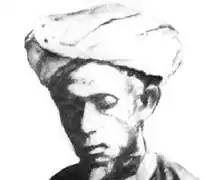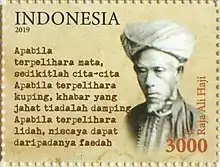Raja Ali Haji | |
|---|---|
 | |
| Born | Raja Ali Haji bin Raja Haji Ahmad 1808 Penyengat Island[1][2] |
| Died | 1873 Penyengat Island |
| Occupation | |
| Language | Bugis (native) |
| Notable works |
|
| Notable awards | National Hero of Indonesia |
Raja Ali Haji (or alternatively known by his patrilineal name as Raja Ali Haji bin Raja Haji Ahmad bin Raja Ali Haji Fisabilillah bin Daeng Celak bin Upu Tenribong Daeng Rilaka) was a 19th-century (1808–1873) Penyengat-born Bugis Muslim historian, poet, scholar,[3] and ulama. He was elevated to the status of National Hero of Indonesia in 2004. His notable works also are recognised as Intangible Cultural Heritage by the Indonesian Ministry of Education and Culture.[4] He is also well-known with his status as the ‘Father of Indonesian language’ (Indonesian: Bapak Bahasa Indonesia) due to his great influence in Indonesian linguistic development.[5][6]
Life

Background
Raja Ali Haji was born in the Indonesian island of Penyengat[1][2] (part of Riau Archipelago) in 1808 or 1809,[7] and ethnically Bugis through the patrilineality and matrilineality kinship. His father, Raja Haji Ahmad was the son of Raja Ali Haji Fisabilillah bin Daeng Celak, who are the Bugis warrior originating from southern Sulawesi.[8][9] His mother, Hamidah binti Malik was a cousin of her father and also of Bugis descent.[10]
Death

Raja Ali Haji died in 1872 at his hometown in the Indonesian island of Penyengat[11] (part of Riau Archipelago), but the precise date of his death was debated. Among the best-known evidences was a letter written in 1872 when Raja Ali Haji wrote a letter to Herman Von De Wall, a Dutch cultural scholar, who later died at Tanjung Pinang in 1873.[12]
Ancestry
| Ancestors of Raja Ali Haji | |||||||||||||||||||||||||||||||||||||||||||||||||||||||||||||||||||||||||||||||||||||||||||||||||||||||||||||||||||||||||||||||||||||||||||||||||||||||||||||||||||||||||||||||||||||||||||||||||||||||||||||||||||||||||||||||||||||||||||||||||||||||||||||||||||||||||||||||||||||||||||||||||||||||||||||||||||||||||||||||||||||||||||||||||||||||||||||||||||||||||||||||||||||||||||||||||||||||||||||||||||||||||||||||||||||||||||||||||||||||||||||||||||||||||||||||||||
|---|---|---|---|---|---|---|---|---|---|---|---|---|---|---|---|---|---|---|---|---|---|---|---|---|---|---|---|---|---|---|---|---|---|---|---|---|---|---|---|---|---|---|---|---|---|---|---|---|---|---|---|---|---|---|---|---|---|---|---|---|---|---|---|---|---|---|---|---|---|---|---|---|---|---|---|---|---|---|---|---|---|---|---|---|---|---|---|---|---|---|---|---|---|---|---|---|---|---|---|---|---|---|---|---|---|---|---|---|---|---|---|---|---|---|---|---|---|---|---|---|---|---|---|---|---|---|---|---|---|---|---|---|---|---|---|---|---|---|---|---|---|---|---|---|---|---|---|---|---|---|---|---|---|---|---|---|---|---|---|---|---|---|---|---|---|---|---|---|---|---|---|---|---|---|---|---|---|---|---|---|---|---|---|---|---|---|---|---|---|---|---|---|---|---|---|---|---|---|---|---|---|---|---|---|---|---|---|---|---|---|---|---|---|---|---|---|---|---|---|---|---|---|---|---|---|---|---|---|---|---|---|---|---|---|---|---|---|---|---|---|---|---|---|---|---|---|---|---|---|---|---|---|---|---|---|---|---|---|---|---|---|---|---|---|---|---|---|---|---|---|---|---|---|---|---|---|---|---|---|---|---|---|---|---|---|---|---|---|---|---|---|---|---|---|---|---|---|---|---|---|---|---|---|---|---|---|---|---|---|---|---|---|---|---|---|---|---|---|---|---|---|---|---|---|---|---|---|---|---|---|---|---|---|---|---|---|---|---|---|---|---|---|---|---|---|---|---|---|---|---|---|---|---|---|---|---|---|---|---|---|---|---|---|---|---|---|---|---|---|---|---|---|---|---|---|---|---|---|---|---|---|---|---|---|---|---|---|---|---|---|---|---|---|---|---|---|---|---|---|---|---|---|---|---|---|---|---|---|---|---|---|---|---|---|---|---|---|---|---|---|---|---|---|---|---|---|---|---|---|---|---|---|---|---|---|---|---|---|---|---|---|---|---|---|---|---|---|---|---|---|---|---|---|---|---|---|---|---|---|---|---|---|---|---|---|---|---|
| |||||||||||||||||||||||||||||||||||||||||||||||||||||||||||||||||||||||||||||||||||||||||||||||||||||||||||||||||||||||||||||||||||||||||||||||||||||||||||||||||||||||||||||||||||||||||||||||||||||||||||||||||||||||||||||||||||||||||||||||||||||||||||||||||||||||||||||||||||||||||||||||||||||||||||||||||||||||||||||||||||||||||||||||||||||||||||||||||||||||||||||||||||||||||||||||||||||||||||||||||||||||||||||||||||||||||||||||||||||||||||||||||||||||||||||||||||
List of notable works

Poems
- 1847: Syair Abdul Muluk (lit., 'The Poem of Abdul Muluk' or 'The Poem of the King's Servant')
- 1847: Gurindam Dua Belas
Books
- 1860s: Tuhfat al-Nafis (lit., 'The Precious Gift')
- 1865: Silsilah Melayu dan Bugis (lit. 'The Genealogy of Malay and Bugis')
Other writings
- 1857: Bustan al-Kathibin
- 1850s: Kitab Pengetahuan Bahasa (uncompleted)
- 1857: Intizam Waza'if al-Malik
- 1857: Thamarat al-Mahammah[3]
Named after Raja Ali Haji
Indonesia
- Maritime University of Raja Ali Haji, a public university located at Tanjung Pinang city in Riau Islands Province.
- Social and Politic Science Institute of Raja Ali Haji, a private institute located at Bestari Hill, Tanjung Pinang city in Riau Islands Province.
- Raja Ali Haji Museum, a tribute museum and mosque complex for Raja Ali Haji located in Batam Island, Riau Islands Province.
- Raja Ali Haji Museum, a complex of museum and mosque located at the coastal area of Tanjung Pinang city, Riau Islands Province.
- Raja Ali Haji Dormitory (Indonesian: Asrama Raja Ali Haji), a college dormitory of the Tanjung Pinang diaspora students' union located at Pandeyan, Yogyakarta.
- Raja Ali Haji Historical Site (Indonesian: Situs Rumah Raja Ali Haji), located at Penyengat, Tanjung Pinang city, Riau Islands Province.
- Raja Ali Haji Mosque (Indonesian: Masjid Raja Ali Haji) located at Tanjung Riau, Batam city, Riau Islands Province.
- Raja Ali Haji Stadium (Indonesian: Stadium Raja Ali Haji), a local little sports stadium located at North Kundur, Karimun Regency, Riau Islands Province.
- Raja Ali Haji Foundation (Indonesian: Yayasan Raja Ali Haji), a private foundation located at Marpoyan Damai, Pekanbaru city, Riau Province.
- Raja Ali Haji Street (Indonesian: Jalan Raja Ali Haji), a street located near the Jodoh River in Batam city, Riau Islands Province.
- Raja Ali Haji Street (Indonesian: Jalan Raja Ali Haji), a street located at Sei Jang, Tanjung Pinang city, Riau Islands Province.
- Raja Ali Haji Street (Indonesian: Jalan Raja Ali Haji), a street located at Bagan Batu, Rokan Hilir Regency, Riau Province.
- Raja Ali Haji Street (Indonesian: Jalan Raja Ali Haji), a street located nead the Beringin River, Indragiri Hilir Regency, Riau Province.
- Raja Ali Haji Street (Indonesian: Jalan Raja Ali Haji), a street located at Bandarsyah, Natuna Regency, Riau Islands Province.
- Raja Ali Haji Street (Indonesian: Jalan Raja Ali Haji), a street located at Kijang Kota, Bintan Regency, Riau Islands Province.
- Raja Ali Haji Street (Indonesian: Jalan Raja Ali Haji), a street located at Empang Baru, Siak Regency, Riau Province.
- Raja Ali Haji Street (Indonesian: Jalan Raja Ali Haji), a street located at Dompak, Bestari Hill, Tanjung Pinang city, Riau Province.
- Local Reading House of Raja Ali Haji (Indonesian: Taman Baca Masyarakat (TBM) Raja Ali Haji), a social library-like place dedicated to local community to engage and improve the linguistic skills of young generations through reading and writing, located at Pinang Kencana, Tanjung Pinang city, Riau Islands Province.
Malaysia
References
- 1 2 "Raja Ali Haji bin Raja Ahmad Bugis prince, historian, and scholar". britannica.com.
- 1 2 Carruthers, Andrew M. (2018). Living on the Edge: Being Muslim and Bugis in the Riau Islands. 30 Heng Mui Keng Terrace, Singapore 119614: ISEAS Publishing (Yusof Ishak Institute). ISBN 978-981-4818-61-2.
{{cite book}}: CS1 maint: location (link) - 1 2 3 Kelly Boyd (1999) Encyclopedia of Historians and Historical Writing. Taylor & Francis. pp. 23-24 ISBN 1-884964-33-8
- ↑ "Gurindam Dua Belas". Cultural Heritage, Ministry of Education and Culture of Indonesia (in Indonesian). Retrieved 25 November 2021.
- ↑ Junus, Hasan (2004). Sejarah Perjuangan Raja Ali Haji Sebagai Bapak Bahasa Indonesia [The History of Raja Ali Haji Struggle as the Father of Indonesian Language] (in Indonesian). Tanjungpinang: UNRI Press. ISBN 9793297999.
- ↑ "Raja Ali Haji dan Kiprah Dibidang Pendidikan" [Raja Ali Haji and His Paces in Education]. Riau Islands Cultural Value Conservation (in Indonesian). Directorate General of Culture of the Republic of Indonesia. 2018.
- ↑ Ali al-Haji Riau, Virginia Matheson Hooker, Virginia Matheson, Barbara Watson Andaya (1982) The Precious Gift: Tuhfat Al-nafis. Oxford University Press. p. 5. ISBN 0-19-582507-1
- ↑ N. J. Ryan (1963) The Making of Modern Malaya: A History from Earliest Times to the Present. Oxford University Press. p. 69
- ↑ Ali al-Haji Riau, Virginia Matheson Hooker, Virginia Matheson, Barbara Watson Andaya (1982) The Precious Gift: Tuhfat Al-nafis. Oxford University Press. p. 277. ISBN 0-19-582507-1
- ↑ Stewart R. Sutherland (1988) The World's Religions. G.K. Hall. p. 42 ISBN 0-8161-8978-1
- ↑ Arya Ajisaka. Mengenal Pahlawan Indonesia. published by Kawan Pustaka. p. 219. ISBN 979-757-278-1
- ↑ Timothy P. Barnard (2004) Contesting Malayness: Malay Identity Across Boundaries. NUS Press. p. 128 ISBN 9971-69-279-1